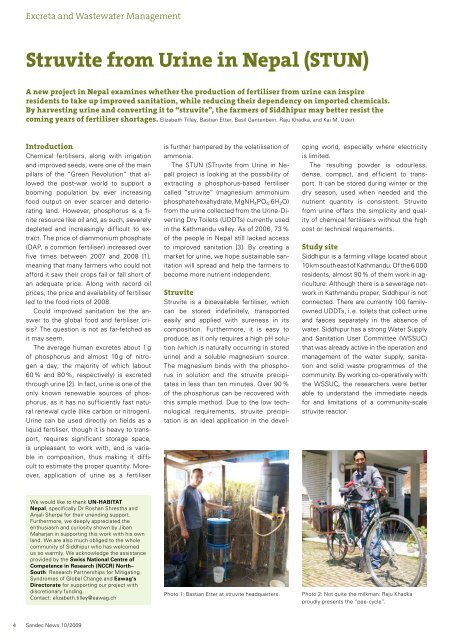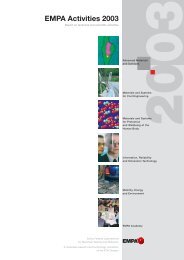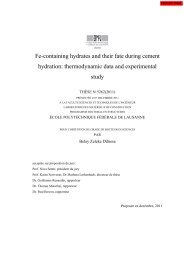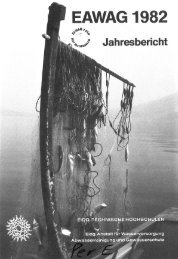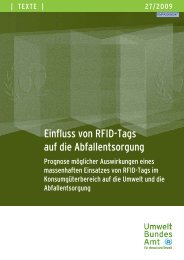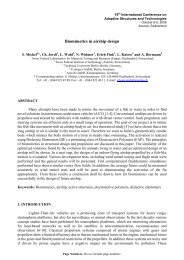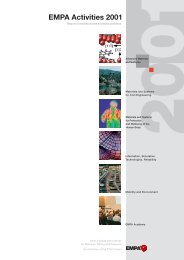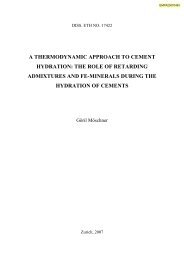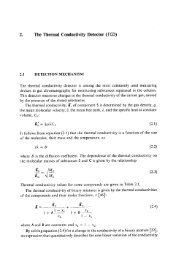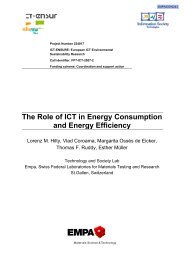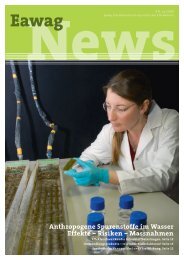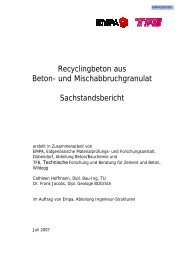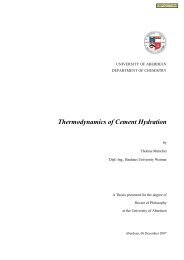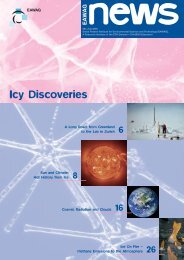Sandec - Eawag
Sandec - Eawag
Sandec - Eawag
Create successful ePaper yourself
Turn your PDF publications into a flip-book with our unique Google optimized e-Paper software.
Excreta and Wastewater Management<br />
Struvite from Urine in Nepal (STUN)<br />
A new project in Nepal examines whether the production of fertiliser from urine can inspire<br />
residents to take up improved sanitation, while reducing their dependency on imported chemicals.<br />
By harvesting urine and converting it to “struvite”, the farmers of Siddhipur may better resist the<br />
coming years of fertiliser shortages. Elizabeth Tilley, Bastian Etter, Basil Gantenbein, Raju Khadka, and Kai M. Udert<br />
Introduction<br />
Chemical fertilisers, along with irrigation<br />
and improved seeds, were one of the main<br />
pillars of the “Green Revolution” that allowed<br />
the post-war world to support a<br />
booming population by ever increasing<br />
food output on ever scarcer and deteriorating<br />
land. However, phosphorus is a finite<br />
resource like oil and, as such, severely<br />
depleted and increasingly difficult to extract.<br />
The price of diammonium phosphate<br />
(DAP, a common fertiliser) increased over<br />
five times between 2007 and 2008 [1],<br />
meaning that many farmers who could not<br />
afford it saw their crops fail or fall short of<br />
an adequate price. Along with record oil<br />
prices, the price and availability of fertiliser<br />
led to the food riots of 2008.<br />
Could improved sanitation be the answer<br />
to the global food and fertiliser crisis?<br />
The question is not as far-fetched as<br />
it may seem.<br />
The average human excretes about 1 g<br />
of phosphorus and almost 10 g of nitrogen<br />
a day; the majority of which (about<br />
60 % and 80 %, respectively) is excreted<br />
through urine [2]. In fact, urine is one of the<br />
only known renewable sources of phosphorus,<br />
as it has no sufficiently fast natural<br />
renewal cycle (like carbon or nitrogen).<br />
Urine can be used directly on fields as a<br />
liquid fertiliser, though it is heavy to transport,<br />
requires significant storage space,<br />
is unpleasant to work with, and is variable<br />
in composition, thus making it difficult<br />
to estimate the proper quantity. Moreover,<br />
application of urine as a fertiliser<br />
We would like to thank UN-HABITAT<br />
Nepal, specifically Dr Roshan Shrestha and<br />
Anjali Sherpa for their unending support.<br />
Furthermore, we deeply appreciated the<br />
enthusiasm and curiosity shown by Jiban<br />
Maharjan in supporting this work with his own<br />
land. We are also much obliged to the whole<br />
community of Siddhipur who has welcomed<br />
us so warmly. We acknowledge the assistance<br />
provided by the Swiss National Centre of<br />
Competence in Research (NCCR) North–<br />
South: Research Partnerships for Mitigating<br />
Syndromes of Global Change and <strong>Eawag</strong>’s<br />
Directorate for supporting our project with<br />
discretionary funding.<br />
Contact: elizabeth.tilley@eawag.ch<br />
<strong>Sandec</strong> News 10/2009<br />
is further hampered by the volatilisation of<br />
ammonia.<br />
The STUN (STruvite from Urine in Nepal)<br />
project is looking at the possibility of<br />
extracting a phosphorus-based fertiliser<br />
called “struvite” (magnesium ammonium<br />
phosphate hexahydrate, MgNH 4PO 4 .6H 2O)<br />
from the urine collected from the Urine-Diverting<br />
Dry Toilets (UDDTs) currently used<br />
in the Kathmandu valley. As of 2006, 73 %<br />
of the people in Nepal still lacked access<br />
to improved sanitation [3]. By creating a<br />
market for urine, we hope sustainable sanitation<br />
will spread and help the farmers to<br />
become more nutrient independent.<br />
Struvite<br />
Struvite is a bioavailable fertiliser, which<br />
can be stored indefinitely, transported<br />
easily and applied with sureness in its<br />
composition. Furthermore, it is easy to<br />
produce, as it only requires a high pH solution<br />
(which is naturally occurring in stored<br />
urine) and a soluble magnesium source.<br />
The magnesium binds with the phosphorus<br />
in solution and the struvite precipitates<br />
in less than ten minutes. Over 90 %<br />
of the phosphorus can be recovered with<br />
this simple method. Due to the low technological<br />
requirements, struvite precipitation<br />
is an ideal application in the devel-<br />
Photo 1: Bastian Etter at struvite headquarters.<br />
oping world, especially where electricity<br />
is limited.<br />
The resulting powder is odourless,<br />
dense, compact, and efficient to transport.<br />
It can be stored during winter or the<br />
dry season, used when needed and the<br />
nutrient quantity is consistent. Struvite<br />
from urine offers the simplicity and quality<br />
of chemical fertilisers without the high<br />
cost or technical requirements.<br />
Study site<br />
Siddhipur is a farming village located about<br />
10 km south east of Kathmandu. Of the 6 000<br />
residents, almost 90 % of them work in agriculture.<br />
Although there is a sewerage network<br />
in Kathmandu proper, Siddhipur is not<br />
connected. There are currently 100 family-<br />
owned UDDTs, i. e. toilets that collect urine<br />
and faeces separately in the absence of<br />
water. Siddhipur has a strong Water Supply<br />
and Sanitation User Committee (WSSUC)<br />
that was already active in the operation and<br />
management of the water supply, sanitation<br />
and solid waste programmes of the<br />
community. By working co-operatively with<br />
the WSSUC, the researchers were better<br />
able to understand the immediate needs<br />
for and limitations of a community-scale<br />
struvite reactor.<br />
Photo 2: Not quite the milkman: Raju Khadka<br />
proudly presents the “pee-cycle”.


